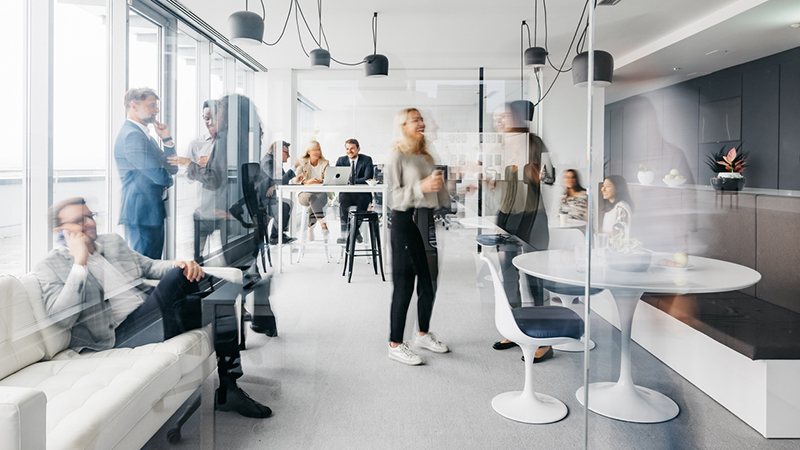How Workplace Culture Is Shifting and Why Your Organization Should Care
From working from home to casual dress codes and overall employee flexibility, the pandemic has brought about a whole new normal for the workplace. Firms unwilling to consider or adapt to these cultural shifts may be at risk for falling behind.
By Indiana CPA Society | Digital Exclusive - 2022

The past few years have propelled workplace culture into ever-changing territory. But even before the pandemic, generational attitudes and emerging technologies were creating pressing conversations around how workplaces function.
“Right now, we are feeling a heightened sense of ‘us versus them’ between organizations' employees and senior leadership when it comes to things like working remotely or working in the office,” said Samantha Julka, president and
founder of DORIS Research, a workplace research firm based in Indianapolis.
Firms that aren’t taking note of these tensions and considering cultural shifts to their organizations are at risk of falling behind—especially when it comes to competing for a currently shrinking talent pool of future CPA professionals. Are
you prepared to move toward meeting their expectations?
The New Office Space
There’s no way around it: the pandemic has created an awakening around whether the traditional office still has merit.
“The next five years will provide us with ample time to really dig in and prototype what the workplace of the future could be,” Julka said.
In general, employees are no longer seeing the physical space as the place where work happens, but instead a place for connection. Sure, it’s important to assess whether or not your team has access to the tech and supplies they need when working
in house. But it’s also important to examine if your space is supporting a positive and productive culture. The more the space is conducive to creating connections and giving team members opportunity to collaborate and engage with each other—both
professionally and personally—the more likely your team is going to want to find themselves in the office.
But there’s no one-size-fits-all solution for all. “The organizations that succeed will do so by truly listening to the needs of all stakeholders involved,” Julka said. “Those that can show empathy and grace for both the needs
of the organization and the needs of the people who make up the organization will achieve far greater success than their counterparts that want to battle over mandates.”
The New Dress Code
Dress codes have been loosening gradually through the years, even in traditionally buttoned-up industries. But Zoom calls and Team communications over traditional face-to-face have loosened expectations even more. What does this mean for the new era of
working in the office?
According to the Journal of Accountancy, HR professionals in firms across the country are getting more creative with approaches to dress codes. One of the most popular tactics is the “dress for your day” policy, giving flexibility to wear
more casual attire—within reason—when employees aren’t handling client-facing tasks for the day, and more appropriate dress on days when meeting with clients. Most keep a back-up ensemble on-hand at the office for surprise meetings.
It’s also important to remember client dress codes are changing, as well. Reflecting their dress code in meetings is becoming increasingly acceptable and, for some clients, preferred.
The New Work Schedule
When people have had a taste of flexibility, they’re not going to want to head back into the box.
“Over 80% of employees want a hybrid schedule and the sweet spot for coming into the office is merely one to two days a week,” said Lindsay Boccardo, a speaker and consultant who helps companies navigate multi-generational workforces. “It
is still helpful to be in person, after all. Just not at the expense of our freedom and productivity.”
A desire for work schedule flexibility isn’t new. The pandemic just pushed us to jump into a “group experiment” where we questioned our productivity without the office and, for many, the standard 9–5 schedule.
“We've known for a decade that millennials wanted flexibility in work life and location. Now the next generation in the workforce, Gen Z, can't imagine a world without it,” Boccardo said.
Gen Z will continue to demand this flexibility, and the generations behind them are likely to expect it.
“They grew up with a desk's worth of work tools in their backpacks,” Boccardo explained. They want to work not only where they want—“What does a desk really offer when my laptop can sit with me in my van by the beach?” Boccardo
mused—but also when they want.
Schedule flexibility is a driving force of employee engagement, a crucial area for helping to address talent pipeline concerns. According to a recent Inc. article: “Engaged employees are both more productive and more likely to stay with you for
the long term. So, giving the people who work for you the flexibility to be good spouses, good parents, good partners, and good friends—as well as good employees—will benefit both you and them.”
While Gen Z and millennials, who are now approaching middle age and more likely to be juggling parenting responsibilities, are quick to embrace this flexibility, it might bring up mixed emotions for others.
“This can be uncomfortable for those of us who worked from an office for decades believing this was the only way. It can also be frustrating,” Boccardo said, especially when coming to the realization working from home could have been happening
for years prior to the pandemic.
The important thing to remember? “Technology has exponentially changed and there is a new way to work that's available to all of us,” Boccardo said.
Reprinted with permission of the Indiana CPA Society.
Related Content: